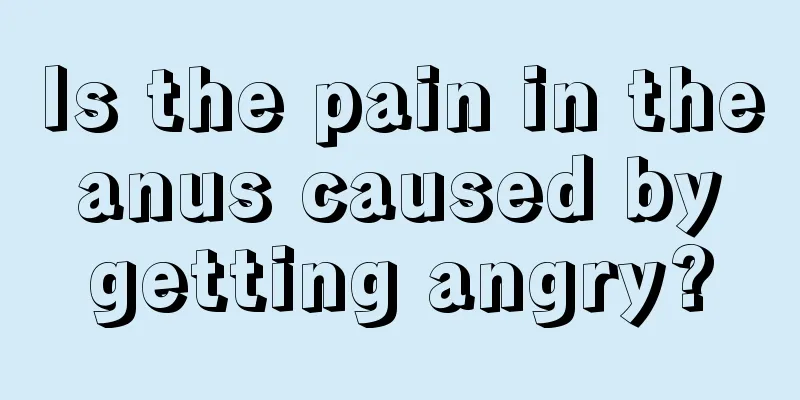Is the pain in the anus caused by getting angry?

|
Pain in the anal area may be related to getting inflamed, because the anus does not get inflamed easily under normal circumstances. Once it does, it will cause pain. It may even be caused by inflammation transmitted by bacteria in the intestines, including hemorrhoids or swelling, anal sinusitis, which are all causes of anal pain in patients and need to be treated after the factors are found. Causes Anal pain is not uncommon in clinical practice. Most patients can find a clear cause, but a small number of patients have unclear causes. Generally speaking, the causes of anal pain are roughly the following: Mental factors: mostly caused by mental stress, such as anorectal neurosis, pudendal nerve syndrome, sciatica, and coccygeal neuralgia reflecting to the anus and causing anal pain; Foreign bodies and bad diet stimulation: Trauma, foreign bodies in the rectum, spicy food and alcoholism can all irritate the anus and cause pain; Anorectal infection: anorectal abscess, anal sinusitis, anal papillitis, etc. These diseases can also cause anal pain; Anal diseases: such as incarcerated hemorrhoids, inflammatory external hemorrhoids, thrombosed external hemorrhoids, anal fissures, anal fistulas, etc., can all cause anal pain; Intestinal infection or diarrhea, constipation: Intestinal infection can cause inflammation to irritate the anus. Diarrhea and constipation can cause mechanical irritation of the anus when feces pass through the anus, resulting in anal pain. Anorectal tumors: Whether benign or malignant, infection of the surface mucosa or direct compression of the anus can cause anal pain. Advanced anorectal cancer can invade the nerves and cause severe pain. Anal pain is caused by the rich sensory nerves in the anus. When stimulated, it will cause pain or severe pain, which may manifest as tingling, distension, burning, and heaviness. It may occur during defecation, after defecation, or at other times. There are many reasons for anal pain, which can be summarized into 12 types; such as pain during defecation and anal fissures, anal sinusitis, incarcerated internal hemorrhoids, and edema of external hemorrhoids; persistent pain caused by bacterial dysentery, amoebic intestinal bleeding, ulcerative colitis, thrombosed external hemorrhoids, perianal abscess, secondary infection of anal fistula, rectal cancer, and foreign body injury in the anus; intermittent pain caused by anorectal neurosis, pudendal nerve syndrome, and rectal inflammation. The top ten causes of anal pain can be summarized as follows: (1) The pain caused by anal fissure is cyclical and often occurs during or after defecation. It is mainly caused by irritation from feces and expansion of the ulcer fissure. The pain is paroxysmal burning or knife-like pain and can last for several minutes; the pain subsides after the stool passes. In addition, due to the stimulation of defecation, the internal sphincter may be in continuous spasm, causing severe and persistent pain in the ulcer fissure; it can often last for several hours, and the patient is restless and in great pain; in severe cases, the pain can last for more than 24 hours. In addition to pain, anal fissures are often accompanied by symptoms such as bleeding and constipation. (2) Anal sinusitis Anal sinusitis, also known as anal cryptitis, is an inflammation caused by lesions in the anal crypts. It is generally characterized by slight pain and heaviness in the anus. During defecation, the stool presses on the inflamed anal sinuses, causing burning pain in the anus. If the sphincter contracts due to stimulation, the pain will intensify and radiate to the buttocks and posterior thigh. It is often accompanied by a small amount of purulent or mucous secretion with a foul odor, which may cause moisture, itching and other discomforts around the anus over time. (3) Patients with mild thrombosed external hemorrhoids may experience a foreign body sensation, often accompanied by swelling and pain. Due to damage to the perianal veins, blood clots form thrombi, and purple round hard nodules appear under the outer skin of the anus, usually at 3 o'clock and 9 o'clock in the lithotomy position. |
<<: Urethra pain after catheter removal
>>: What is the cause of pain in the shoulder seam
Recommend
The difference between cleansing gel and facial cleanser
There are both differences and similarities betwe...
What is grade 3 hypertension
When it comes to hypertension, everyone should be...
What are the benefits of silver to the human body
Since ancient times, people have longed to wear g...
What are the dangers of wearing traditional dentures
In our daily life, many people enjoy sweets to br...
What to do if you are poisoned by Aconitum kusnezoffii
Many people think that Chinese medicine is effect...
Why your skin becomes dark even without sun exposure
Some people have darker skin because they don'...
What is the pad used for
For girls, sanitary pads are indispensable during...
How to strengthen prostate cancer prevention from the dietary aspect? Eating more of these five types of food can prevent prostate cancer
Prostate cancer has become a relatively common tu...
Are abdominal muscle trainers useful?
Nowadays, men all hope to have beautiful abdomina...
What are the symptoms of gallbladder cancer
Typical symptoms of gallbladder cancer include ga...
What should I do if I really want a divorce?
As we all know, the divorce rate in today's s...
What is the difference between male and female crabs
Crabs can be divided into male crabs and female c...
Swimming crab and flower crab
Many people like to eat crabs. Crabs are rich in ...
What foods can improve the body's ability to excrete waste?
In daily life, there are many factors that can ca...
What is Vitamin E for external use
Vitamin E is also called vitamin E. Vitamin E is ...









